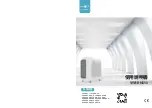
A: Lo service valve B: Hi service valve
C and D are the ends of indoor unit connection.
CAUTION
●
Refrigerant leak test
1.
Soapy water method:
Apply a soapy water solution to the
indoor and outdoor unit connections
using a soft brush. If there are bubbles
observed at the connections, this is
confirmation of a refrigerant leak. The
2.
Leak detector
Use a handheld leak detector to check for leaks.
15
A,B,C,D are points for one outdoor-four indoor systems.
A,B,C,D, E are points for one outdoor-five indoor systems.
Indoor unit
check point
Outdoor unit
check point
22
Fig.69
NOTE:
This diagram is for illustration purposes
only. The actual order of the A, B, C, D & E
connections on the system may differ slightly
from the unit to unit depending on the model.
Check the actual system for final configuration.
E
Commissioning / Test run
Perform a test operation after completing a leak test at the flare nut connections and after a
full electrical safety check.
Check that all pipe work and wiring have been properly connected.
Check that the gas and liquid service valves are fully open.
1. Connect the power, press the ON/OFF button on the remote control to turn the unit on.
2. Use the MODE button to select COOL, HEAT, AUTO and FAN to check the operation of
all of the functions.
o
3. When the ambient temperature is too low (lower than 17 C), the unit cannot be controlled by
the remote control to run in cooling mode, but manual operation can be selected. Manual
operation is used only when the remote control is disabled or maintenance is necessary.
Hold the indoor unit front panel sides and lift the panel up to an angle until it clicks, and remains
open at an angle.
Press the Manual control button to select the AUTO or COOL, the unit will operate under
a Forced AUTO or COOL mode (see User Manual for details).
4. The test operation will last for approximately 30 minutes.
Fig.70
Manual control
button
AUTO/COOL
TEST RUNNING
leak must be repaired before restarting.


































